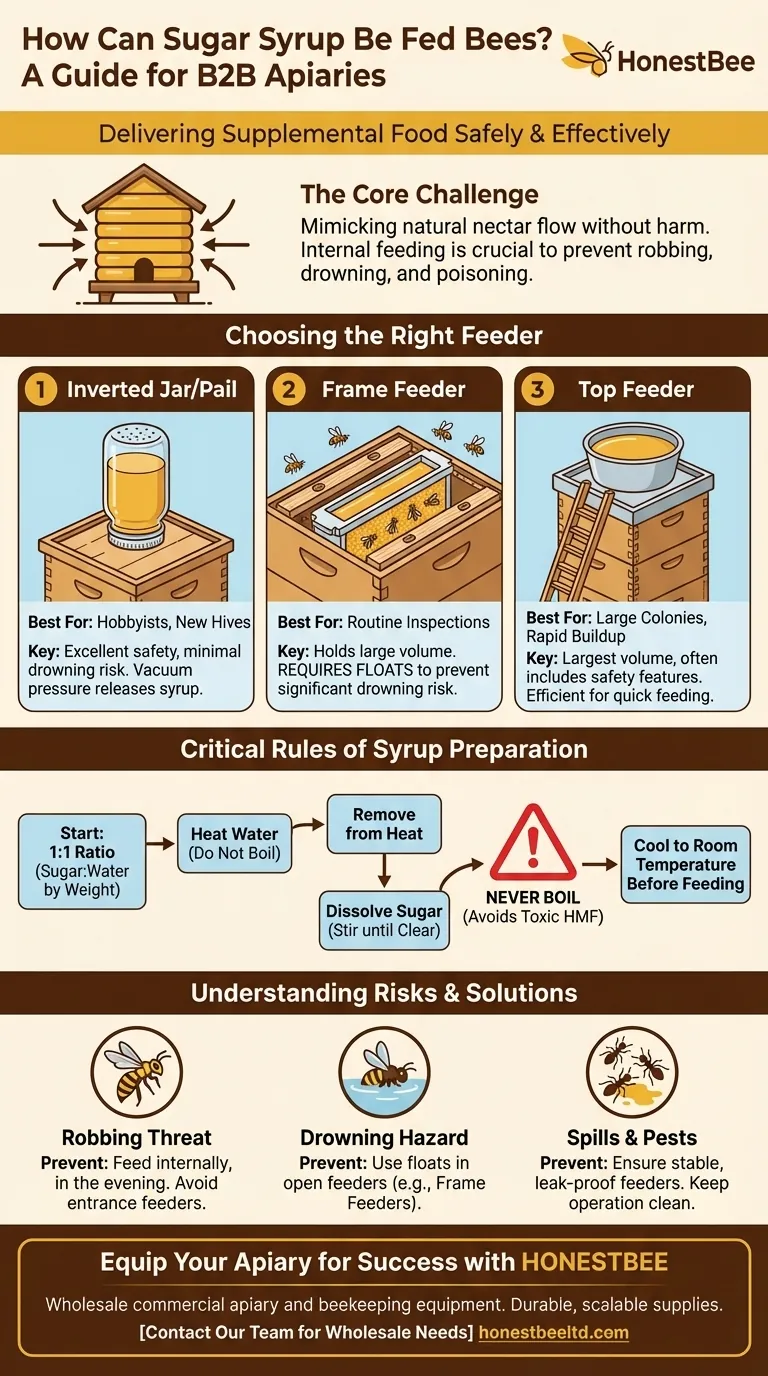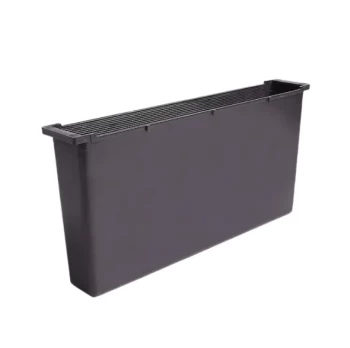To feed sugar syrup to bees, you use a specialized container known as a feeder. The most common types are internal frame feeders, large top feeders, and inverted gravity feeders like Mason jars or pails, all of which are placed inside the hive to provide a supplemental food source without exposing the colony to outside threats.
The core challenge of feeding bees isn't just delivering sugar; it's doing so in a way that mimics a natural nectar flow without causing accidental harm. Your choice of feeder and your preparation technique directly impact hive health, preventing issues like drowning, fighting, and poisoning.

Choosing the Right Feeder: A Look Inside the Hive
Feeders are almost always placed inside the hive. This is a critical best practice to prevent "robbing," where bees from other colonies attack the hive to steal the rich food source.
The Inverted Jar or Pail Feeder
This is the most common method for hobbyists. A standard Mason jar or a larger pail is filled with syrup, and the lid is perforated with tiny holes.
The container is then inverted over the hole in the hive's inner cover. The vacuum pressure keeps the syrup from pouring out, allowing bees to drink from the holes as needed. This method is exceptionally safe, as it nearly eliminates the risk of bees drowning.
The Frame Feeder
A frame feeder is a thin, plastic container shaped exactly like a frame of honeycomb. It is placed inside the hive body, taking the place of one of the brood or honey frames.
These feeders hold a large volume of syrup but are open at the top. This design creates a significant drowning risk. To mitigate this, you must provide floats—such as pieces of wood, cork, or a plastic float designed for the feeder—for the bees to stand on.
The Top Feeder
A top feeder is a large basin that sits on top of the uppermost hive box, directly under the outer cover. These feeders hold the largest volume of syrup, often several gallons.
Most modern designs include built-in ladders or screened-off compartments that allow bees to access the syrup without falling in, making them a very effective and safe option for feeding large colonies quickly.
The Critical Rules of Syrup Preparation
How you make the syrup is just as important as how you deliver it. Improperly prepared syrup can be ineffective or even toxic to your bees.
The Standard 1:1 Ratio
For most feeding situations, such as stimulating a new colony or supporting a hive during a nectar shortage, a 1:1 ratio of sugar to water by weight is the standard.
The Safe Mixing Process
The goal is to fully dissolve the sugar without scorching it. The correct method is to heat the water until it is very hot but not boiling.
Remove the water from the heat source before adding the sugar. Stir until the liquid is completely clear. Undissolved sugar crystals can recrystallize in the feeder, making it useless.
The Most Important Rule: Do Not Boil
Never boil the sugar and water mixture. Boiling can cause the sugars to caramelize and produce Hydroxymethylfurfural (HMF), a compound that is toxic to bees.
Always Cool Completely
Before giving the syrup to your bees, it must be cooled to room temperature. Hot syrup can severely injure or kill the bees that consume it.
Understanding the Trade-offs and Risks
Choosing to feed your bees requires you to manage a few key risks to ensure you are helping, not harming, the colony.
The Threat of Robbing
Robbing occurs when strong, foraging bees from other hives discover a weak hive's food source. Feeding can trigger this behavior if not done carefully.
To prevent robbing, always place feeders inside the hive. You should also place the feed in the hive towards the evening, after most foraging bees have returned to their own colonies for the night. Avoid entrance feeders, as they create an obvious "help yourself" sign for robbers.
The Drowning Hazard
As mentioned, any open-style feeder presents a risk of bees drowning in the syrup. While top feeders often have safety designs, always double-check. For frame feeders, adding floats is not optional—it's essential.
Preventing Spills and Pests
Syrup spills inside or outside the hive will attract ants, wasps, and robbing bees. Ensure your feeders are stable and not leaking. A clean feeding operation protects the colony from unwanted attention and stress.
Making the Right Choice for Your Hive
Your feeding strategy should align with the specific needs of your colony at a given time.
- If your primary focus is safety and simplicity for a new hive: The inverted jar feeder is cheap, easy to manage, and minimizes drowning risk.
- If your primary focus is rapid buildup for a large colony: A top feeder offers the largest volume, reducing the frequency of refills.
- If your primary focus is integrating feeding into routine inspections: A frame feeder allows you to check feed levels while the hive is already open, but requires diligent use of floats.
Responsible feeding is a powerful tool that empowers you to support your bees when nature falls short.
Summary Table:
| Feeder Type | Best For | Key Considerations |
|---|---|---|
| Inverted Jar/Pail | Hobbyists, New Hives | Excellent safety, minimal drowning risk. |
| Frame Feeder | Routine Inspections | Requires floats to prevent drowning. |
| Top Feeder | Large Colonies, Rapid Buildup | Holds large volume, often has safety features. |
Equip your apiary with the right tools for success. Feeding your bees is a critical management task, and having reliable, high-quality equipment is essential for hive health and productivity. At HONESTBEE, we supply commercial apiaries and beekeeping equipment distributors with the durable, wholesale-focused supplies needed to manage colonies effectively. From robust top feeders to safe frame feeders, our products are designed to support your operation's scale and success.
Contact our team today to discuss your wholesale needs and ensure your bees are fed safely and efficiently.
Visual Guide

Related Products
- HONESTBEE Professional Hive Top Bee Feeder Feeding Solution
- HONESTBEE Round Hive Top Bee Feeder for Syrup
- HONESTBEE Entrance Bee Feeder Professional Hive Nutrition Solution for Beekeeping
- HONESTBEE Advanced Ergonomic Stainless Steel Hive Tool for Beekeeping
- Rapid Bee Feeder White Plastic 2L Round Top Feeder for 8 or 10-Frame Bee Hives
People Also Ask
- What is a top feeder for bees? Maximize Colony Health with Efficient Feeding
- What are the advantages of hive top feeders? Maximize Feeding Efficiency for Your Apiary
- What features make top feeders a reliable choice for beekeepers? A Guide to Safe, Efficient Hive Nutrition
- What should be done with feeders and equipment after feeding bees? Essential Steps for Apiary Health
- Why is a top feeder essential for bees? Ensure Colony Health and Efficiency



















